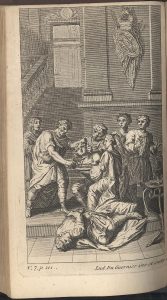Shakespeare’s Culturally Relevant Halloween Story.
It is that time of year again. It is starting to feel like fall and Halloween is right around the corner. Netflix is coming out with their top Halloween picks. And a category such as “gory” or “gruesome” is bound to be featured, as it is nearly every year. If you are like me, not only do you enjoy a scary film, but there are also books that fit the season. Maybe you are cracking open Bram Stoker’s Dracula or Stephen King’s Carrie. However, I just may have a new recommendation for you. Shakespeare’s Titus Andronicus is a horror story that would definitely be featured on Netflix’s gory or gruesome film choices. And, believe it or not, it would be appealing to the same fans who adore American Horror Story or Sweeney Todd. But apart from appealing to the horror genre buff, this play addresses some issues that may be very close to home.

Although this story features a horrific fourteen killings, six severed members, one rape, one live burial, one case of insanity and an instance of cannibalism, we can find a number of these barbaric acts relevant to today’s culture. First and foremost, the issue of racism is addressed through these events. Titus Andronicus’ opposing sides consist of the Romans, which are revealed to be the more civilized pale skinned people, and the Goths, the darker skinned people known for their lawlessness and tactlessness. These are simply cultural biases that our culture is no stranger to. However, as the story progresses, both parties commit crimes of hatred, causing the audience to wonder who the heartless and reckless people really are in the end.
Secondarily, the themes of sexism and rape are ever present. Unfortunately, being a college student at a large public university means students are exposed to this horrible occurrence on almost a weekly basis. The girl who is raped in the play also suffers a be-handing and the severing of her tongue, causing her to be unable to communicate or help herself. This causes me to wonder if this symbolism accurately reflects how many women who are victims of sexual violence and assault feel today.
While the amount of violence and gore in this play may seem overwhelming and overdone, critics often question whether Shakespeare had the same intents as Quentin Tarantino does in his films, such as Once Upon a Time in Hollywood in which the gore was portrayed in nearly a comedic way because of its hyperbolic nature. Could Shakespeare’s work, (classified as a tragedy) be a comedic act representing a sobering and horrific cultural reality?
This Halloween season, I encourage you to delve into the world of Titus Andronicus in order to immerse yourself in a horror story that is of utmost cultural relevance and perspective. Maybe it could possibly serve as entertainment that enlightens you about the state of our society.
Shakespeare, William. The Works of Shakespeare. Vol. 7, London, J. Tonson, 1728. SpecCol R.B. PR 2752 .P7 v. 7